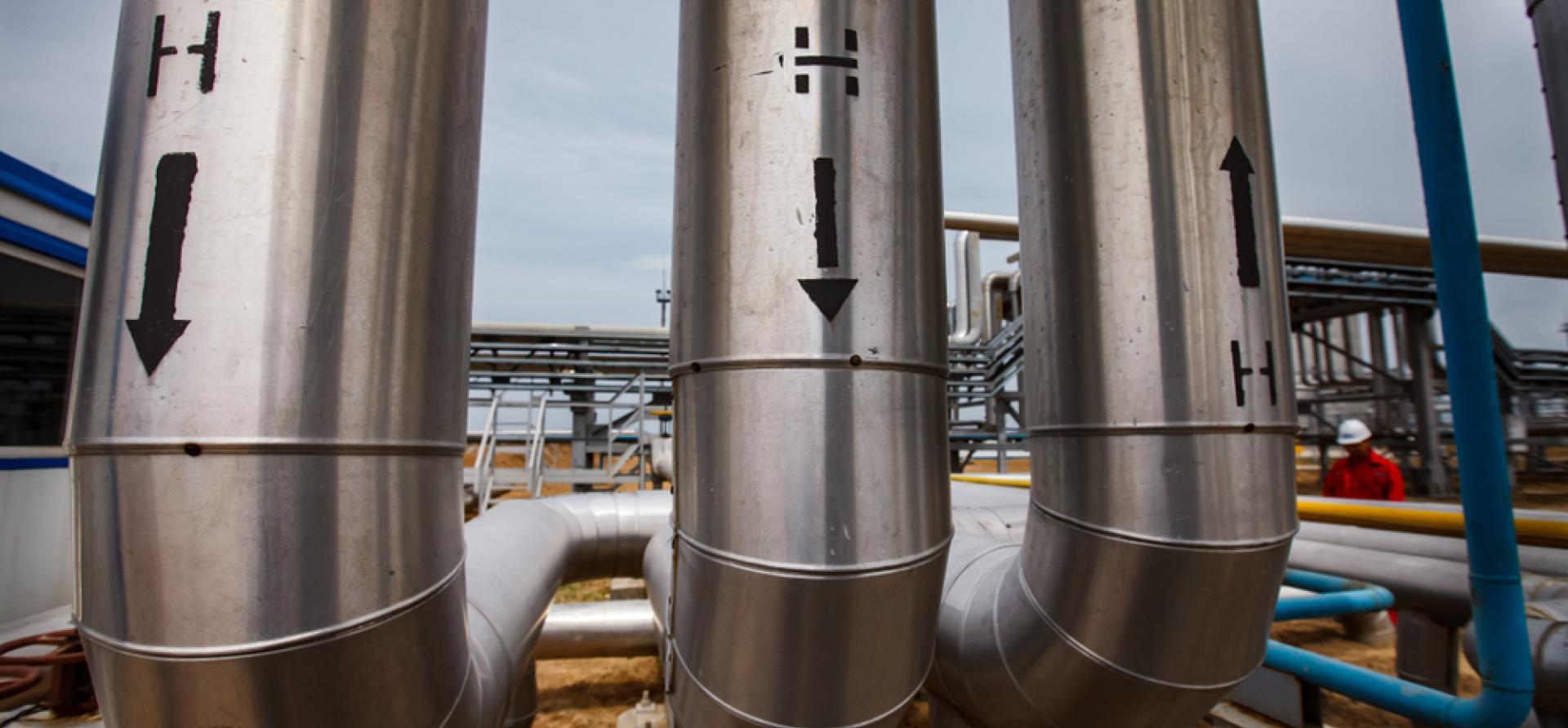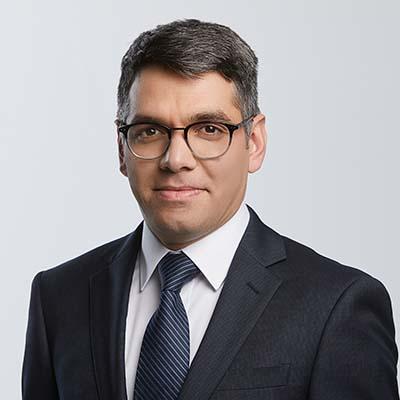Leveraging green hydrogen to lower MENA steel sector emissions

Key Findings
Steelmakers in the MENA region could reduce their emissions by making their current fleet of gas-based DRI plants into hybrid systems before fully switching to hydrogen.
While ensuring an uninterrupted supply of green hydrogen round the clock presents a significant challenge for steelmakers, there is an opportunity to produce lower-emissions iron by partially replacing natural gas with hydrogen in existing DRI plants.
With the partial substitution of hydrogen, the facility size can be smaller, leading to lower capital costs and a more manageable transition process.
Direct reduction (DR) ironmaking is a continuous process, requiring a constant supply of energy and of reducing gas to strip the oxygen out of iron ore. Producing green iron demands a substantial amount of green hydrogen as the reducing gas, which necessitates abundant renewable energy to power electrolysers. With their variable nature, renewable sources like solar and wind struggle to deliver the seamless, uninterrupted power supply that electrolysers need.
One way to overcome this challenge is to firm up power generation with robust electricity storage systems that can support hydrogen production when the wind isn’t blowing and the sun isn’t shining. Alternatively, constructing oversized electrolysers and renewables to produce and store green hydrogen can ensure a steady supply when renewable energy is unavailable. Each approach has its pros and cons, and the combination of renewables available in various regions will determine the best configuration of the hydrogen value chain.
To run a green steel facility using a solar photovoltaic (PV) utility, with a 20% capacity factor and no battery support, the electrolyser’s size must be increased by a factor of 3.5. Supporting this augmentation requires a solar utility oversized by a factor of five. This increases project capital expenditure (capex), making the transition to green steel more challenging.
In January 2024, IEEFA discussed how these barriers are driving the initial round of green iron and steel production to regions with cheap low-emissions energy from the grid that is mostly generated by a mix of renewables and hydropower. Having access to low-emission grid electricity is a unique advantage that is not a viable option for many regions.
Green hydrogen production relies heavily on the local renewables profile. In certain regions, electrolysers should be directly connected to renewable energy sources, despite the constraint of limited operational hours. In the Middle East and North Africa (MENA), the availability of cost-effective renewable resources with limited seasonal variability can reduce the size of the electrolyser and hydrogen storage units required.
Given the availability of gas-based DR technology in the MENA region and its flexibility in utilising various hydrogen mixes, a short-term solution could involve producing hydrogen intermittently and replacing gas consumption to the greatest extent feasible. This could be an important initial step in the green steel transition for MENA producers.
DR technology’s compatibility with hybrid reducing gases
Powering direct reduced iron (DRI), electric arc furnace (EAF) facilities with pure hydrogen around the clock represents a monumental shift. Along with the scale of the electrolysers and renewables required to power large-scale steel mills, stringent regulations such as the EU, US and Canada’s three pillars (additionality, time matching and geographical matching) impose significant restrictions on hydrogen production. Breaking down this formidable task into smaller, more manageable steps is sensible.
DRI technology has the flexibility to operate with varying hydrogen mixes. Both major providers of gas-based DRI technologies worldwide have made it clear that injecting hydrogen into current furnaces is feasible. Midrex, the largest supplier of DR shafts, has consistently stated that it is possible to replace up to 30% of natural gas with hydrogen without modifying existing equipment. Danieli and Tenova, developers of the Energiron technology, have confirmed that their plants are hydrogen-ready and can operate with various blends of hydrogen. Energiron can reportedly use up to 80% hydrogen in the short term with an unchanged plant configuration.
Therefore, a gradual transition for steelmakers already operating gas-based DRI technology seems like a promising solution. The gradual substitution approach will facilitate better risk management for investors and enable steelmakers to adopt new technology more effectively.
Adopting a gradual substitution strategy must be prioritised by steelmakers that have already utilised gas-based DRI technology. The configuration of low-emission iron and steel plants in the MENA, which accounts for 46% of global DRI production, will be crucial for reducing emissions from current steel mills. By partially using hydrogen instead of gas, these plants can establish a value chain that paves the way for truly green iron production in the region.
However, while partial transition can enable the downsizing of project scopes for electrolysers, renewables and storages, barriers still remain to be addressed.
Challenges and opportunities
Hydrogen electrolysers continue to face challenges due to the variability of renewable energy sources. These challenges can result in issues such as low efficiency and higher cost, and potential safety concerns.
Electrolysers have a safe operational range and a certain capacity factor (actual operating capacity compared to nominal capacity) that must be carefully managed. Operating outside this range can be dangerous due to the potential mixing of hydrogen with oxygen, creating a highly explosive mixture. While developers claim different safe ranges (usually 10%-100%), maintaining at least 50% capacity is considered a more conservative and safer figure.
A comprehensive review of 130 studies on the impacts of intermittency in electrolyser production reveals a unanimous consensus: variations in temperature and electrical load significantly affect efficiency, gas purity and durability. While most of these studies emphasise the negative effects of intermittency, there is a notable scarcity of real-world operational data. More practical experience is crucial to fully understand the barriers facing intermittently powered electrolysers. Overcoming this challenge could establish a new era in hydrogen production via electrolysis, as seen with proton exchange membrane (PEM) technology, which appears promising for operating effectively with variable renewable power input.
Despite these challenges, studies have shown that producing green hydrogen intermittently can be cost-effective. This approach might eliminate the need to oversize renewable energy and battery storage capacities to match the full capacity of electrolysers. Research from Stanford University found that the lowest hydrogen production costs using wind, water and solar energy sources could occur when operating electrolysers at 20%-65% of their capacity factor.
There are also ideas about using curtailed electricity for green hydrogen production. While some studies suggest it is technically feasible, additional support may be needed to make it commercially viable. The South Australian Government is investing A$593 million to develop a hydrogen production, generation and storage facility in Whyalla. The project encompasses 250 megawatts (MW) of electrolyser capacity, a 200MW hydrogen-fuelled power plant and hydrogen storage infrastructure. The hydrogen produced will be utilised for power generation and industrial applications, including ironmaking at the nearby Whyalla steelworks.
Gradual CO2 reduction can align perfectly with the European Union (EU)’s Carbon Border Adjustment Mechanism (CBAM) regulations, which are set to phase in from 2026 for exports to the EU, with CBAM credits progressively increasing until 2034. The MENA region can maintain and even expand its iron and steel trade with the EU, given its potential to produce low-emissions products with lower embedded carbon that comply with EU regulations.
While the first generation of true hydrogen-based green iron plants, from companies such as H2 Green Steel, HYBRIT and Blastr, is being developed in Nordic countries with low-emissions electricity from the grid, the MENA has an opportunity to make its current fleet of gas-based DRI plants hybrid, before fully switching to hydrogen. Hydrogen developers and steel producers in the region must seize this opportunity.















